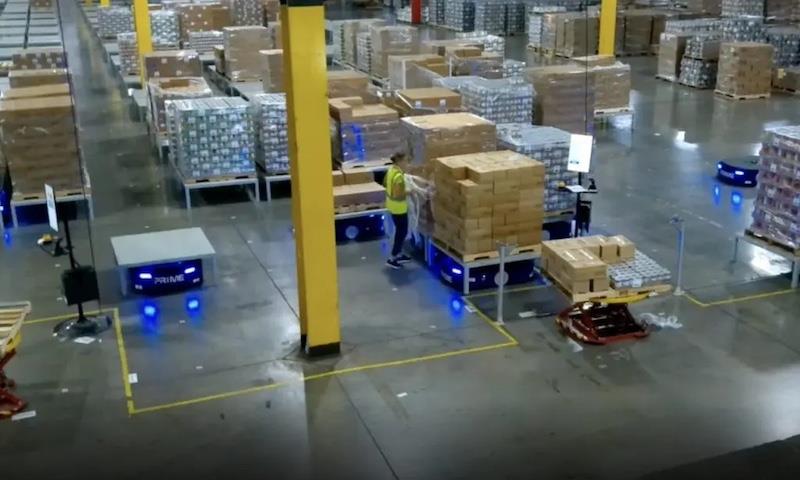
Revolutionizing Logistics With Mixed Case Palletizing For Food And Beverage Robotics & Automation News
In the fast-moving industry, food and beverage logistics, time, and accuracy are of utmost importance. One solution to the problem that is taking the industry by storm today is mixed-case palletizing.
This innovative method makes it possible for a number of different products to be stocked on one pallet, which in turn improves the efficacy of a network.
Let us learn some of the advantages of mixed case palletizing for the food and beverage industry along with its versatility, and usage.
Introduction to Mixed Case Palletizing for Food and BeverageMixed-case palletizing for the food and beverage sector entails the systematic stacking of various products in a pallet to facilitate storage, transportation, and handling.
Unlike palletizing, which involves stacking symmetric products, mixed-case palletizing entails the proper arrangement of multiple specific SKUs.
Due to the multitude of products, including small and large packages, it is especially applicable to the food and beverage industries.
The Need for Mixed Case Palletizing in Food and BeverageDiverse Product Lines: Beverage companies and food manufacturers deal with different products, ranging from bottled products in different sizes to different food products that come in different shapes and sizes. Mixed case palletizing for food and beverages facilitates this kind of diversity.
Frequent SKU Changes: New products are often launched into the market, and old products are often dropped into the market; hence, there is a need to develop a palletizing system that can swiftly be adapted in the changing industry.
Retailer Demands: Many retailers may require certain arrangements of products on the pallets to ensure efficient stocking on shelves. These demands are met by mixed case palletizing, which assembles individual pallets for each retailer.
Benefits of Mixed Case Palletizing for Food and BeverageSpace Optimization: Mixed case palletizing intelligently organizes different products in a single pallet, hence optimizing the space in the pallet. This saves on the amounts of pallets that would otherwise be required for warehousing the products and transportation.
Improved Efficiency: Automated mixed case palletizing systems enhance productivity as they are faster than manual palletizing systems.
It is important to note that these systems have the capability of addressing the issues of stacking in as much as the patterns adopted involve a lot of precision and/or speed.
Enhanced Order Accuracy: Mixed case palletizing for food and beverages helps in arranging the right products on the pallet to avoid order errors. This is important for ensuring customer loyalty and reducing the rate at which customers take back products.
Cost Savings: As this method ensures that there is proper utilization of the pallet space, the risks and costs of storage, transport, and employment are reduced.
Sustainability: The concept also minimizes the utilization of pallets in general transportation and storage systems, thereby decreasing the overall effect on the environment.
Technologies Enabling Mixed Case PalletizingRobotic Palletizers: These automated systems involve the use of robots that have special end effectors that enable them to pick up goods and place them on pallets. They are suitable for processing numerous types of packaging as well as for sorting them with a high degree of accuracy in terms of stacking.
Computer Vision: High-precision vision systems facilitate robots to locate and place the product with great precision. This technology helps in the proper positioning of each item in a way that it will only easily fall or take up a little space.
Artificial Intelligence (AI): They improve palletizing by choosing the most suitable arrangements of products that will fit together on pallets. This saves time for planning and, therefore, enhances productivity.
Applications of Mixed Case Palletizing in Food and BeverageBeverage Distribution: Mixed case palletizing is preferred in the beverage industries to deal with issues of varied bottle sizes and packaging methods. This makes it possible to achieve the optimal pallet loads that the retailer usually demands.
Grocery Retail: Grocery retailers are advantaged through mixed case palletizing of the food and beverages as they are presented with pallets that facilitate shelving and occupy less backroom space.
Food Service: Mixed case palletizing allows food service providers to organize a wide range of products in a way that will meet clients' demands after delivery.
E-commerce Fulfillment: As online grocery shopping continues to grow, e-commerce fulfillment centers employ mixed case palletizing for proper, accurate, and unique arrangements for direct consumer delivery.
ConclusionThe manner in which food and beverage products are delivered, transported, and stored is being revolutionized by mixed case palletizing.
This cutting-edge method boosts productivity, guarantees order accuracy, and maximizes pallet space, among other advantages for the business.
Mixed case palletizing for the food and beverage industry will play an increasingly bigger role in the logistics of food and drink as technology develops, increasing both customer pleasure and operational performance.
Legal Disclaimer:
MENAFN provides the
information “as is” without warranty of any kind. We do not accept
any responsibility or liability for the accuracy, content, images,
videos, licenses, completeness, legality, or reliability of the information
contained in this article. If you have any complaints or copyright
issues related to this article, kindly contact the provider above.


















Comments
No comment